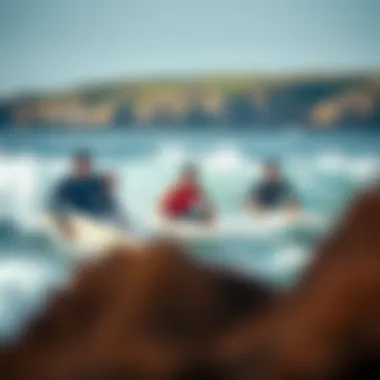Choosing the Right Longboards and Surfboards for Beginners


Intro
Diving into the world of watersports can be both thrilling and overwhelming, especially for newcomers. Many enthusiasts see the waves and just feel that undeniable pull to join in. As more people are attracted to longboarding and surfing, understanding the nuances of the equipment makes a world of difference. This article explores the essentials of selecting the ideal longboard and surfboard, focusing on factors such as construction materials, design features, and intended usage. The aim here is not just to flood you with options but to lay out a clear path to making informed decisions that enhance your experience in these exhilarating sports.
Choosing the right board might seem trivial at first glance, yet it impacts your performance, safety, and enjoyment. From beginner to intermediate levels, it’s crucial to grasp what differentiates a good board from a great one. Whether you're drawn to the steady glide of longboarding or the rush of catching a wave on a surfboard, knowing what to look for will empower you on your journey.
Consider this your compass as we navigate the waters together, uncovering the details that matter most to those just starting out. This guide is here to help demystify options and provide practical insights, paving the way for a rewarding entry into the realm of longboarding and surfing.
Prelims to Longboarding and Surfing
Longboarding and surfing are more than just recreational activities; they embody a culture that resonates with the rhythm of the ocean and the pulse of the pavement. This article aims to shed light on the essentials for those beginning their journey in these exhilarating sports. It’s pivotal to understand that engaging in longboarding or surfing introduces you not only to adrenaline but also to a community and a lifestyle that revolves around balance, control, and freedom.
The nuances of choosing the right longboard or surfboard can be quite overwhelming—especially if you’re just starting out. Factors like the board's construction, size, and design directly impact your experience. Finding the ideal match helps a beginner enjoy a smoother ride and lays the groundwork for advancing skills. Here, we’ll dive into the fundamental aspects and considerations you should keep in mind as you embark on your longboarding or surfing adventure.
Understanding the Appeal of Longboarding
Longboarding has caught the attention of many for various reasons. For starters, the sense of freedom it offers can feel liberating. As you glide along, there’s a feeling akin to flying, combining the thrill of speed with the ease of handling a longer, more stable board compared to its shorter counterpart known as a skateboard. The wide decks allow for greater stability, which is especially advantageous for beginners still finding their balance.
Visually, longboarding is a graceful sight—riders performing tricks or simply cruising can appear almost like dancers amidst the backdrop of urban landscapes or scenic routes. Beyond aesthetics, the sensory experience is paramount. The wind rushing past, the shift of weight as you carve through turns, and the way your heart races as you pick up speed, all contribute to its allure. Many riders cite longboarding as a form of stress relief, attributing their soothing mental state to the rhythmic motion and concentration required.
The Connection Between Longboarding and Surfing
The ties between longboarding and surfing run deep. Both sports share foundational principles of balance and movement, making them complementary pursuits. Generally, surfers recognize a kinship with longboarders, as both crafts navigate similar waves—of water and concrete, respectively. In both instances, riders harness their body weight to maneuver and achieve fluid motion.
Moreover, in terms of tool-building, the evolution of longboards echoes the advancements seen in surfboards. Longboard shapes and designs often draw inspiration from surfboards, tailored to accommodate varied environments. For instance, you'll see a shift in functionality; where surfers may glance at breaking waves, longboarders might seek out their favorite downhill slopes.
Understanding these connections can provide new entrants to either sport valuable insight. Engaging in longboarding, for instance, can enhance a surfer’s agility and control, making those first wave rides less daunting. Likewise, grasping wave dynamics from surfing might improve one’s longboarding techniques.
The Fundamentals of Selecting a Longboard
When stepping into the world of longboarding, it's crucial to understand the nuances behind selecting the right board. Choosing a longboard isn't merely about picking out any random model; it’s about finding one that fits your personal style, skating needs, and goals. A well-chosen longboard can enhance your experience significantly, making learning easier and more enjoyable. This section delves into the essential elements that will guide you in choosing a longboard appropriate for beginners, covering various types available as well as crucial design features to consider.
Types of Longboards Available
There are numerous types of longboards, each catering to different styles of riding and terrain. Understanding these options can make a big difference in your longboarding journey.
Drop-Through Longboards
Drop-through longboards feature a design that allows the trucks to be mounted through the deck, lowering the board’s center of gravity. This aspect provides an enhanced sense of stability and control, making it a popular choice among beginners. The key characteristic here is the ease of pushing. You don’t have to lift the board much off the ground; you simply place your foot down and glide with ease.
The unique benefit of drop-throughs is their fluid maneuverability, ideal for cruising or commuting. However, they may lack some responsiveness that more experienced riders look for while carving sharp turns.
Drop-Down Longboards
Drop-down longboards have a deck that lowers in the center, providing another level of stability. This configuration allows riders to maintain balance easily while rolling downhill or making tight turns. The primary characteristic is the lower overall height, reducing the risk of wiping out.
Considering their stability and balance, drop-downs serve as an excellent option for those new to longboarding. However, they might not be the best fit if you crave speed or want to perform tricks, as their design tends to favor cruising over acrobatics.
Top-Mount Longboards
In contrast to drop-through and drop-down boards, top-mount longboards have the trucks mounted on top of the deck. This design offers a more responsive ride, allowing for tighter turns and quicker maneuvers. Newbies might appreciate getting a feel for the board, but the raised height can make it a bit challenging for starters.
Top-mounts are a solid choice if you're looking to progress your skills quickly, as they adapt well to various styles of riding. However, carving can feel a little twitchy at first, requiring some practice to harness effectively.
Electric Longboards
Electric longboards are setting trends for many newcomers due to their motorized capabilities. These boards give riders the chance to experience speed without heavy legwork, making longboarding even more accessible. Typically, you control an electric longboard using a handheld remote, which can be very appealing to those starting out.
While the convenience of electric longboards is undeniable, they carry certain drawbacks. They often require batteries, which means downtime when not charged, and can be occasionally pricier due to the electronic components.
Key Features to Consider
Once you have a grasp of the various types of longboards, it’s essential to consider specific features that can impact your riding experience.
Deck Material and Shape
The board's construction material and shape play vital roles in its overall performance. Common materials include maple, bamboo, and fiberglass. Maple provides sturdiness, while bamboo is prized for its lightweight flexibility, allowing smoother rides. Each material affects the board’s weight, durability, and responsiveness.
The board shape also reflects its intended use: wider decks offer more stability, while thinner boards allow for quicker turns. For beginners, a solid balance of both aspects is vital to help ease the learning curve while retaining enough performance as skills improve.
Wheels and Bearings
Another key component is the wheels and bearings. These two elements determine how smoothly you roll over various surfaces. Softer wheels typically grip better on rough terrain, while harder wheels offer a quicker ride on flat surfaces.
The bearings, often rated with the ABEC scale, indicate how fast the wheels can spin. A higher ABEC rating generally means a faster ride, but remember that for beginners, smoother, slower riding might be more beneficial until comfort develops on the board.


Truck Types
The trucks, which connect the wheels to the board, can greatly affect maneuverability and ride quality. Longboard trucks come in two main types—traditional and inverted. Traditional trucks tend to provide greater stability, while inverted trucks can offer more flexibility for riders aiming to push their boundaries.
For beginners, it is usually best to select trucks that strike a balance between stability and flexibility. This will offer a safer learning platform while still allowing for experimentation as skills progress.
By fully understanding the fundamentals of longboard selection, you validate your decision-making process as a beginner. Knowledge is a powerful tool, paving the way for better rides as you traverse the beautiful world of longboarding.
Criteria for Choosing a Surfboard
Selecting the right surfboard can feel a bit like finding a needle in a haystack for newcomers. The sheer variety available can be overwhelming, and it’s easy to feel lost at sea. However, picking the right board is crucial for a satisfying surfing experience. Focusing on certain aspects can guide your choices and make your entry into the sport smoother.
Understanding the various types of surfboards, their dimensions, and how they might affect your surfing helps in identifying what fits your style and skill level. After all, the aim is not just to stand up but to feel comfortable and in sync with the waves. Let’s dive deeper into the specifics, which can greatly enhance your learning curve and enjoyment.
Types of Surfboards for Beginners
Soft-Top Surfboards
Soft-top surfboards stand out as the go-to option for many beginners. Their most appealing feature is the foam top, which provides an added layer of safety. This is particularly significant for new surfers who might not yet have mastered balance and control. When you fall—and you will—having a softer surface means fewer bumps and bruises.
Another key characteristic of soft-tops is their buoyancy. This makes paddling out to catch waves easier, allowing newbies to spend more time on the board instead of struggling in the water. Plus, they often come in wider designs, offering better stability. However, the downside is that they’re often less maneuverable than harder boards, which can limit performance as skills progress. For those beginning their journey, soft-tops strike a good balance of safety and ease of use.
Funboards
Funboards take their name seriously—they're indeed enjoyable for new surfers. Typically a bridge between longboards and shortboards, Funboards offer the paddling ease of a longboard with some maneuverable benefits of a shortboard. They tend to be around 7 to 9 feet long, providing great stability but still allowing for turning and progression as skills improve.
The unique feature of Funboards is their versatility. They fit a variety of wave conditions and suit a range of surfing styles. New surfers can experiment while feeling safe and supported, making them a fan-favorite for those eager to get up on the waves. On the flip side, they can be a bit heavy, which might make carrying them around after the session somewhat cumbersome.
Longboards
Revered for their smooth ride, longboards continue to charm surfers, especially those just starting. Available in lengths of 8 feet or more, their size aids in paddling and catching waves. They are stable and are generally associated with a slower, more graceful form of surfing.
One noteworthy trait of longboards is their ability to excel in smaller, weaker waves. Beginners can ride them with confidence, allowing for easy wave catching without high-speed maneuvers. However, their size can be a double-edged sword; they can be challenging to turn compared to shorter boards, which might pose a challenge as beginners progress and desire to explore more dynamic surfing.
Understanding Board Dimensions
Length, Width, and Thickness
The dimensions of a surfboard—length, width, and thickness—play a pivotal role in how it behaves in the water. Beginners particularly benefit from selecting the right dimensions, as these affect balance, paddling ease, and overall ride. Longer boards tend to provide more stability, while shorter boards offer nimbleness.
A common guideline is that the board should be approximately 6 to 12 inches longer than the rider's height, ensuring better buoyancy and ease in catching waves.
One distinct advantage of focusing on length is the enhanced glide that longer boards offer, making it easier to travel over water and catch waves effectively. However, a longer board can be cumbersome for those yet to develop advanced skills, potentially leading to difficulties in maneuvering.
Volume and Its Impact on Stability
Volume plays a crucial role in determining the buoyancy and stability of a surfboard. Measured in liters, a higher volume means more floatation. This factor is especially essential for beginners who might benefit from a more buoyant board that helps prevent them from sinking.
A surfboard with adequate volume allows easier paddling and balance, crucial for new surfers trying to catch their first waves. While more volume provides stability, beginners must find a balance; too much can hinder swift maneuverability in more challenging conditions. Thus, understanding volume becomes a vital part of the board selection process.
Materials and Construction of Longboards and Surfboards
Selecting the ideal longboard or surfboard doesn't boil down to just aesthetics or cost. The materials and construction of these boards play a pivotal role in performance, longevity, and overall user experience. In essence, understanding the makeup of these boards can open a door to better choices on the water. A well-constructed board, using suitable materials, can significantly enhance a newcomer’s skills and enjoyment, leading to a more fulfilling initiation into the world of watersports.
Popular Materials in Longboard Manufacturing
Bamboo
Bamboo is often celebrated for its natural resilience and flexibility. It contributes to a lightweight yet strong board that can withstand considerable wear and tear. The key characteristic of bamboo that raises its profile is its eco-friendly nature. For those looking to minimize their carbon footprint, choosing bamboo could be a game-changer. One unique feature is its ability to absorb shock, which allows for smoother rides on rugged terrains. However, bamboo longboards may not be as stiff as those crafted from harder materials, which might affect performance during aggressive maneuvers.
Maple
Maple is a stalwart in the world of longboard materials. Its durability is unmatched, making it a popular choice among both beginners and seasoned riders. The dense wood offers excellent stability and provides a solid feel while riding. Its springy quality adds a certain pop during pushes or tricks, enhancing performance. An important aspect is how it can retain its integrity over time, despite regular use. On the flip side, maple boards tend to be heavier, which could prove challenging for those just starting out, potentially making them less maneuverable.
Fiberglass
Fiberglass is another notable material in longboard making, especially for its combination of lightweight and robust characteristics. This synthetic material allows for intricate design patterns while ensuring a strong build. Its key advantage is resistance to water and general wear and tear, making fiberglass longboards suitable for various conditions. The downside lies in the price—fiberglass boards are typically on the higher end of the spectrum. Also, they can be less forgiving on bumps due to their rigidity, which might discourage newer riders from exploring their limits.
Surfboard Construction Materials Overview
Polyurethane Foam
Polyurethane foam is widely recognized as the standard material for surfboards, largely due to its lightness and buoyancy. This type of foam provides excellent floatation, making it a favored choice for beginners who are still mastering paddle techniques and balance. The smooth surface aids in achieving acceleration on waves. However, it’s worth noting its susceptibility to water damage; if not properly sealed, this material can absorb water, compromising the board's integrity over time.
Epoxy Resin
Epoxy resin marks an advancement over traditional construction materials in surfboards. A significant advantage is its toughness and impact resistance, making it a favorable option for surfers navigating challenging conditions. Epoxy surfboards typically are lighter and provide better buoyancy than their polyurethane counterparts. The trade-off, however, comes in the form of a higher price tag. Additionally, for those looking for flexibility, epoxy boards can feel stiffer compared to traditional options, which might not suit everyone's style.


Advanced Composite Materials
Advanced composite materials employ a mixture of substances to enhance specific characteristics like strength and weight. These boards can offer tailored benefits, such as improved agility, stability, and durability. By utilizing a combination of materials, manufacturers can target the unique needs of different surfers. The downside? They can come with a steeper learning curve if designers try to achieve too many specialized features; thus, beginners might not reap the full benefits until they refine their skills. Furthermore, costs for advanced composites can escalate quickly, making them less accessible for casual users.
It's essential that both metal and wood selections in longboarding and surfing make informed decisions based on personal needs, skill level, and riding style. Select wisely, and the board can significantly enhance your experience in the water.
Understanding these various materials and how they affect both longboards and surfboards can aid in making educated choices that will serve newcomers well as they step into the waves.
Essential Tips for Beginner Longboarders
Getting started with longboarding can be a thrilling yet daunting experience. It's crucial for newcomers to grasp some essential tips that can ease their entry into this exhilarating sport. The importance of understanding these tips lies not just in enhancing one’s riding skills but also in boosting confidence on the board. Safety, balance, and the right mindset can significantly impact the learning curve, making the journey smoother and far more enjoyable.
Safety Gear Recommendations
Helmets
When it comes to safety gear, helmets are non-negotiable. Beginner longboarders are likely to take a few tumbles while finding their footing. A quality helmet provides vital protection for your head, reducing the risk of serious injury. It's often said that a helmet is like a seatbelt for skaters. Investing in a snug, comfortable helmet can make all the difference. Look for ones with a safety certification, as these helmets have gone through rigorous testing.
A unique feature to note in many helmets is the inclusion of ventilation ports. These allow for air circulation, which keeps the rider cool during rides. While wearing a helmet might seem cumbersome at first, it ultimately aids your focus, knowing your head is safe, allowing you to concentrate on learning and enjoying the ride.
Knee Pads
Knee pads also play a vital role in protecting beginners from potential scrapes and bruises. They are designed for comfort while providing cushioning for your knees in case of falls. The best knee pads fit snugly and offer good mobility, helping you maintain your balance and stance on the board. An interesting aspect of knee pads is their varied designs, some even featuring hard shells that offer added protection.
Though knee pads might feel awkward at first, they can radically reduce the fear of falling. This newfound confidence enables beginners to practice various maneuvers and tricks without second-guessing themselves.
Elbow Pads
Elbow pads are often overlooked but just as important as helmets and knee pads. They protect the elbow from impact and abrasion. When you fall, elbows tend to hit the ground first. A well-fitted pair of elbow pads ensures that even if you take a tumble, your joints are cushioned against harsh landings. Look for elbow pads that contain soft foam padding, which absorbs shock effectively.
Some elbow pads come equipped with adjustable straps for a personalized fit, making them more user-friendly. While they might not be the first piece of gear you think of, having a solid elbow padding can save you from those pesky aches and ensure you keep riding without interruptions.
Learning to Ride: Starting with Balance
Once you're geared up, the next vital aspect is learning how to ride with balance. Balance isn't just about stability on the board; it's also mentally tuning into how your body shifts and reacts to different movements. One effective method is to practice standing on the board while stationary. Find a flat, safe spot and just stand on your longboard, feet shoulder-width apart. This helps in getting familiar with the feeling of balance before you start moving.
Experiment with shifting your weight gently from one foot to the other. Start with simple shifts to the front and back, then gradually involve sideways movements. This initial practice can greatly enhance your sense of balance and control when you start rolling.
Taking things slow is key. Don't rush into carving or pushing too hard until you feel confident in your ability to stay upright. The journey of longboarding is all about building your skills step-by-step and finding joy in mastering each aspect of the sport.
Fundamentals of Surfing for Newcomers
The world of surfing may seem daunting at first glance, particularly for those with no previous experience. However, understanding the fundamentals of surfing is essential for anyone looking to ride the waves with confidence and skill. This section aims to break down the foundational elements that every newcomer should grasp, allowing them to enjoy the experience and ensure safety while progressing in their surfing journey.
Surfing is not merely about balancing on a board; it involves a nuanced understanding of the ocean, wave dynamics, and personal technique. The elements discussed here will provide the groundwork that can help beginners to build their skills and develop a deeper connection with the ocean. From recognizing the right conditions to perfecting techniques, newcomers will have a solid launching pad into the vibrant world of surfing.
Choosing the Right Waves for Beginners
One of the first lessons for new surfers is recognizing that not all waves are created equal. Choosing the right waves is critical for safety and enjoyment. Beginners should ideally look for smaller, slower waves that offer a gentle push, giving them ample time to practice their balance and paddling.
Less powerful waves provide a safer environment to learn without the overwhelming force of larger swells. Shorebreak waves or slow rollers found at smaller beaches are often ideal for beginners. Factors like tide, wind conditions, and surf forecasts should be considered when determining which waves to approach. Platforms like Surfline or Magicseaweed can deliver valuable forecasts tailored to local conditions.
Basic Surfing Techniques to Master
Mastering basic surfing techniques is essential for beginners, acting as the building blocks for more advanced maneuvers in the future. Here are some key techniques that every newcomer must focus on:
Paddling Out
Paddling out is the gateway to entering the surfing realm. It’s the method of propelling yourself through the water to reach the lineup, where the waves break.
A vital aspect of paddling out is understanding positioning. This helps surfers navigate through breaking waves efficiently. Strong paddling not only gets you closer to the surfable area but also allows you to conserve energy, which is precious in the waves. Developing a strong stroke and learning to angle your board correctly can make the difference between a stress-free paddle or a tumultuous battle with the ocean. However, a common mistake among newcomers is overexertion; less is often more when it comes to paddling.
Pop-Up Technique
The pop-up technique is your ticket to standing on the board and riding a wave. This movement transitions you from lying on your stomach to standing upright swiftly and smoothly. It requires practice and timing. New surfers often practice on the beach to perfect their timing and foot positions, which is essential for maintaining balance once in the water.
Getting it right means you won't end up face-planting in the water constantly, which can be both frustrating and disheartening. Learning to pop up efficiently can significantly impact how comfortable you feel on the board.
Turning and Stopping
Once you've managed to stand on the board, the next phase involves learning how to turn and stop. This is crucial for navigating the waves, avoiding obstacles, or getting back to the shore.
Turning is often accomplished by shifting weight, either by pressing down on the back foot or leaning on one side. Stopping usually involves heading towards the beach, carefully maneuvering your surfboard toward the shallows. Beginners might find these skills tricky at first but mastering them can make all the difference in avoiding wipeouts and increasing their enjoyment in the water.
Overall, taking the time to comprehend and practice these fundamentals will set newcomers on a path toward becoming competent surfers. As with any sport, patience and perseverance will yield progress and satisfaction.


"The ocean stirs the heart, inspires the imagination, and brings eternal joy to the soul." – Wyland
By concentrating on these basic skills, any aspiring surfer can embark on their journey with a clear understanding of the essential principles of the sport.
Longboarding vs. Surfing: Which is Right for You?
When it comes to selecting a sport between longboarding and surfing, it’s a choice that goes beyond just preference; it involves understanding your lifestyle, location, and even your personality. Both activities offer a thrilling way to connect with the outdoors, but they each require different mindsets, skills, and even equipment. So, what really sets them apart, and how do you decide which is the best fit for you?
Comparative Analysis of Both Sports
Both longboarding and surfing share a laid-back vibe, a connection to the sea, and an active community. Yet, they differ significantly in practice and philosophy. Here’s a closer look at how they stack up against one another.
Accessibility: Longboarding is more accessible. You can find a smooth road or pathway around almost any corner, and you don't need to wait for waves. Surfing, on the other hand, often requires travel to specific beaches and conditions.
Learning Curve: Beginners will find longboarding easier initially. Balancing on a board and rolling downhill tends to be less intimidating than learning how to paddle out and catch a wave. In contrast, surfing requires mastering techniques like paddling and timing before you can even start riding the waves.
Social Aspects: Both sports foster community, but they manifest differently. Longboarding often promotes a casual atmosphere where you can ride with friends or join local groups without the pressure of waves. In surfing, there's often a competitive edge even among friends, as many surfers aim to catch the best waves and perform tricks.
Physical Engagement: Surfing demands more upper body strength for paddling out, while longboarding is more about lower body control and balance. Activities like carving and sliding require core stability, but don’t tire you out as quickly as paddling through ocean swells.
Understanding these differences can clarify what you value in a sport and what fits with your routine. For those who lean towards spontaneous adventure, longboarding is usually the winner. But if you crave the thrill of chasing waves and riding the energy of the ocean, surfing might be your calling.
Personal Preferences and Lifestyle Considerations
Choosing between longboarding and surfing is also a matter of personal lifestyle. Here are some factors that can shape your decision.
Location: Think about where you live. Are you near the beach, or do you live inland? If you're nowhere near good waves, longboarding is likely more practical. On the flip side, living along the coast opens a treasure chest of surfing possibilities.
Time Commitment: Surfing can require significant time to learn and improve, especially as conditions vary widely. Longboarding allows for more leisurely rides; you can go out for a quick session whenever it suits your schedule.
Social Influence: Consider your social circles. If most of your friends are into one sport or the other, that can make things easier. Group dynamics can significantly enrich experiences and keep you engaged.
Physical Fitness Goals: Both sports contribute to fitness but in different ways. Longboarding offers a gentler introduction to balancing and core strength, while surfing demands more from your upper body and agility.
By understanding these factors, you’ll be in a better position to choose the sport that aligns with your daily life and values. Remember, there’s no wrong choice; many enthusiasts enjoy both!
Remember: It’s not just about choosing one sport over the other but finding what aligns with your life, goals, and passions. Whatever you decide, both longboarding and surfing can be immensely rewarding.
Tips for Sustaining Longboard and Surfboard Maintenance
Maintaining your longboard and surfboard is crucial for preserving their performance and aesthetics over time. Just like any piece of equipment, they require a bit of attention and care. Neglecting maintenance can lead to diminished ride quality or, worse, potential safety issues.
When you invest time and money into selecting the ideal board for your style, keeping that board in tip-top shape makes all the difference. Routine maintenance ensures not only longevity but also an enjoyable experience whenever you hit the waves or the pavement.
Routine Care and Cleaning Essentials
Regular cleaning is an often overlooked aspect of maintaining your longboard and surfboard. It’s not just about appearance; dirt, grime, and salt can affect the board’s condition.
- Wash with Freshwater: After surfing, particularly in saltwater, rinse your board with freshwater. This simple step helps remove any salt residues that might corrode the materials over time.
- Use Non-Abrasive Cleaners: For tougher stains, opt for non-abrasive cleaners or mild dish soap mixed with water. Use a soft cloth or sponge to scrub gently. Avoid steel wool or abrasive pads that could scratch the surface.
- Inspect Regularly: Look for any cracks or delaminations in the board. Addressing these issues early can save you more costly repairs later. If a crack is spotted, temporary fixes like a repair patch can keep it from getting worse until a proper fix is done.
- Condition the Material: For boards with fiberglass or epoxy, consider applying a UV protectant to minimize sun damage. This step will reduce fading and help in maintaining the board's vibrant colors.
Important: Regular maintenance can extend the life of your gear significantly. It's akin to getting regular check-ups for your health; it might seem tedious, but it pays off in the long run.
Storage Solutions for Longevity
Where you store your boards can be just as important as how you clean them. Proper storage can protect your investment, ensuring it stays in great shape and ready for use.
- Keep Indoors: Whenever possible, store your longboard and surfboard indoors, away from direct sunlight and extreme temperatures. Keeping them in a garage or a storage room will protect them from environmental factors that can lead to wear and tear.
- Use Board Bags: Invest in a good quality board bag for additional protection when storing or transporting your board. A padded bag can prevent dings and scrapes during travel, which is crucial for maintaining integrity, especially for surfboards made with sensitive materials.
- Avoid Weight Pressure: Do not stack heavy items on top of your boards. This can lead to warping and other structural issues. Instead, consider using a vertical storage rack that allows boards to be displayed safely while conserving space.
- Lay Flat: If you must store your boards in an outdoor location, keep them flat instead of propped up. This helps prevent warping and ensures even weight distribution to avoid pressure marks.
"Proper care and storage not only keep your gear looking new but also enhance its performance when you’re ready to ride."
Ultimately, making a habit of regular maintenance and thoughtful storage can transform your longboarding and surfing experience. It ensures that every ride is enjoyable and safe, allowing for a seamless experience in the engaging world of water and pavement sports.
Closure: Embarking on Your Longboarding and Surfing Journey
As you stand at the brink of diving into the exhilarating worlds of longboarding and surfing, it’s crucial to appreciate that this journey goes beyond merely selecting the right board. In this article, we've explored the vibrant landscapes of both sports, underlining the essentials that cater specifically to beginners. Understanding your desires and capabilities can dramatically enhance your experience, transforming what might have been a daunting endeavor into a memorable adventure.
To embark on this journey, focus on key elements such as your personal style, the type of terrain you’ll navigate, and the conditions of the water you wish to conquer. Each decision you make—whether it’s opting for a soft-top surfboard or a drop-through longboard—symbolizes more than equipment; it represents a commitment to adventure and enjoyment.
Summarizing Key Insights
To encapsulate the insights we’ve gathered throughout this guide, consider the following:
- Types of Boards: Knowing the differences between longboards and surfboards is vital. Longboards are versatile and stable, making them ideal for cruising, especially for newcomers, whereas surfboards provide the thrill of catching waves.
- Material Choices: The construction of your board affects performance. For instance, lightweight boards made from epoxy or bamboo can be easier to handle, particularly for beginners.
- Safety First: Never underestimate the importance of safety gear. Helmets, knee pads, and elbow pads can prevent injuries, keeping your focus on mastering skills.
- Wave Selection: Knowing which waves to tackle can make or break your initial experience. Start small and gradually build your confidence.
These elements, when understood and applied, act as the foundation for your journey into longboarding and surfing. Take the time to assess your needs and preferences; it will yield a more fulfilling experience.
Encouragement for New Enthusiasts
Stepping into the realm of longboarding and surfing can feel intimidating. The thought of balancing on a narrow board or paddling out into the ocean's vastness might raise questions. However, approach this new chapter with an open mind and willingness to learn. Each wipeout teaches a lesson, and every roll down the pavement offers insight into your capabilities.
Engage with local communities. Online forums like reddit.com/r/surfing or Facebook groups about longboarding can connect you to fellow enthusiasts who share their experiences and tips.
Ultimately, the thrill of gliding down a hill or riding a wave is a reward worth pursuing, so share in the journey with others and keep the spirit of adventure alive. It’s not just about the destination; it’s the experiences and relationships forged along the way that truly matter. Embrace every moment, and you might find that this journey is one of the most enriching adventures of your life.







